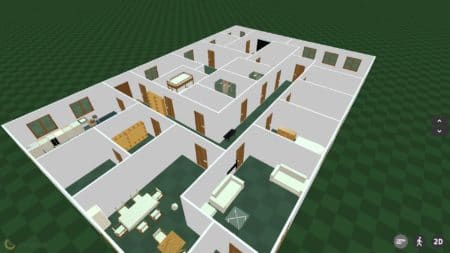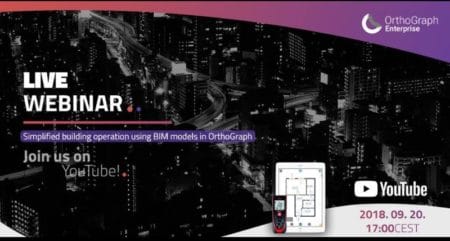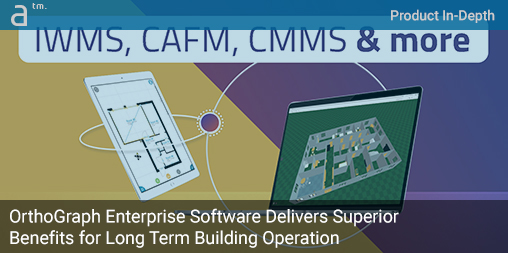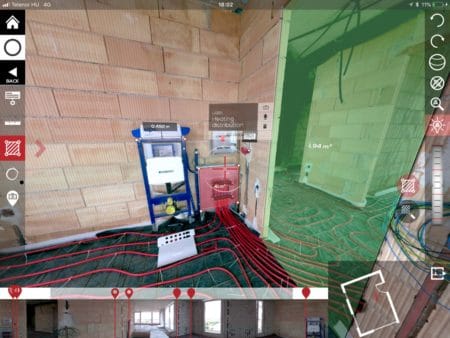ORTHOGRAPH’S AWARD-WINNING BUILDING SURVEY SOFTWARE has expanded to the enterprise level in the recent year and this summer we had a chance to talk to the company about their latest offerings.
“OrthoGraph is sitting between the real buildings and the objects in it and the CAFM and ERP systems used by facility managers and building operators,” says Adam Korbuly, strategic director, OrthoGraph. “This is how real life becomes connected to the BIM world.”
The Evolution of OrthoGraph Enterprise
The Mobile App
Korbuly explained to Architosh the various components of the OrthoGraph Enterprise software, a BIM Model Management Platform. At the heart of this platform is the latest version of OrthoGraph Enterprise the mobile building survey app. The Hungarian software developer continues to improve this app’s ability to accurately and quickly survey buildings.
Some of the latest improvements include enhancements to the measurement workflows, intelligent location alignments, and support for freestanding walls and curved walls. All these improvements conspire to make the business of measuring buildings even easier. To understand how to survey buildings with OrthoGraph you can read our older product review here. (see: Architosh, “Product Review: OrthoGraph I—Building Survey System for AEC Pros,” 21 Feb 2017).
OrthoGraph is sitting between the real building and the objects in it and the CAFM and ERP systems used by facility managers and building operators. This is how real life becomes connected to the BIM world.
Korbuly noted that the very latest version of OrthoGraph Enterprise “includes a vastly more intelligent building survey engine” with something Korbuly called “measurement tolerances” that smooth out the workflow, particularly for first-time users. As Architosh has discussed before, in our hands-on review, OrthoGraph Enterprise is a mobile app that works most efficiently when paired with a laser distance meter (LDM). And it works optimally on both iOS and Android operating systems.
Enterprise Features
The key to OrthoGraph Enterprise is the OrthoGraph Cloud and third-party API support. The new web viewer enables multiple users to view BIM models that automatically are generated via OrthoGraph Enterprise on the iPad, for example. (see image 01)
The web viewer can display real estate datasheets generated by the mobile app and published to the OrthoGraph Cloud.

01 – OrthoGraph Cloud provides BIM modeling viewing, along with 2D floor plans and reports, inside the browser from the cloud with data attached to elements.
New QR code support means that every item inside a building can be scanned if it has a QR code label somewhere visible to a handheld smartphone or iPad. Once scanned OrthoGraph Enterprise will automatically take you to the item in the plan or BIM model. This will be an invaluable feature for facility management professionals. In the web viewer, the BIM model also shows per element property data and provides both 2D and 3D views of the BIM model. (see image 02)
With the third-party API support, this data can be connected to third-party applications such as CAFM (computer-aided facility management) and CMMS (computerized maintenance management system) solutions. (see image 03) “OrthoGraph Enterprise can actually be connected to anything,” adds Adam Korbuly, strategic director, OrthoGraph, “but I should emphasize that not only do you have access to all the elements [in the BIM] and their sizes but also the calculations inside OrthoGraph—the net sizes of rooms, for example.”
The Value Proposition
Having a BIM model in the hands of a facilities manager, complete with per-element data, is an obvious win for building owner-operators, especially if that data is tied to an actual BIM model you can explore in both 2D and 3D from anywhere in the world, via OrthoGraph Cloud.

03 – OrthoGraph Enterprise has an open API for connections to leading CAFM, CMMS, and enterprise ERP applications, connecting measured, scanned and tagged BIM model element data to these systems.
But it is important to know that “as-built conditions” of buildings differ from original plans by 5-10 percent, on average. OrthoGraph’s industry research has concluded that this 10 percent imprecision could equal the total cost of the building over a building’s operational life-cycle (30-50 years). Where might this cost actually be coming from?
One clear example is in inaccurate leasable areas. The Hungarian software developer provided me with one example of a structure that was 170m x 50m over six stories. Just a 2 percent difference would cause a 1-meter difference across the whole length. It could mean over 1000 square meters could not be producing any money for the owner, but it would still be heated, cleaned and maintained. Based on some standard European market values, the example given yielded a loss of as much as 146,000.euros per year or 4.4 million euros over 30 years. Clearly, accurate leaseable areas and building areas, in general, are critical data that building owner-operators must have.
But there are other areas where lost of money due to inaccuracies matter. In maintenance and repairs, facilities managers are greatly advantaged when they know exactly what is behind walls, ceilings, and floors. This is where OrthoGraph’s latest offering to the market comes in.
Leica BLK360 Laser and App
Korbuly clarifies the problem further in my discussions with him. He makes the very accurate point that not every BIM project has all of its piping, electrical, and other systems fully modeled as part of the building BIM model. And though such elements would be useful down-stream for building operations and maintenance, it is doubtful they would be placed in construction in the exact spot they may be placed in the BIM model.
So how do building operators get this type of information located into a BIM model exactly where it exists?
OrthoGraph’s BLK360 App
One method now possible and utilized is to deploy the use of 360-degree laser scanners during construction to provide a highly-accurate point cloud data model of exactly every element in the building prior to when walls, floors, and ceilings are enclosed and much of the building’s systems and structure become invisible to the naked eye. (see image 04)

04 – Leica’s BLK360 laser device is not only powered by an OrthoGraph app custom created for it but the device integrates into the OrthoGraph Enterprise workflow.
The process involves utilizing a device like the Leica BLK360 laser scanner. Such a device produces a 3D point cloud, which we have written about on Architosh before (see: Architosh, “Using the Future of Architecture to Save Its Past,” 14 June 2016) ) For this specific device, OrthoGraph of Hungary was called upon to write an app called the BLK360 App for mobile devices like the iPad Pro.
With a 3mm accuracy of elements that are eventually hidden behind finishes, OrthoGraph’s BLK360 App for the Leica BLK360 laser scanner records all the details of a building while it is being built or renovated.
According to Korbuly, the new BLK360 app is based on similar technology as OrthoGraph itself. However, the app is very different and based around the needs of controlling and operating the Leica BLK360 laser scanner. (see image 05) After setting up the device on a tripod within a room, it takes just three minutes generally to complete a 360 spherical scan. The scan is a point cloud; it produces about 1 million points per minute. The device also produces an HDR spherical panorama color photograph which is superimposed over the point cloud data. And the device also has a thermal imaging sensor and produces a thermal image panorama.
Korbuly makes the argument to me that it isn’t truly necessary to model all the piping and electrical elements into a BIM model because using the BLK360 with the BLK360 App, you can scan the location of all these elements prior to plastering or finish and have all this data within 3 mm accuracy of the elements of the architecture.
The BLK360 app enables the user to measure and tag elements via the Measurement & Tagging menu item. This is extremely useful for FM work once a building is operational. Having precise data about elements behind and inside walls and ceilings is important, having their exact location even more so. (see image 06).
With the BLK360 app, the user can also create floor plans and BIM models, via the Floor Plan menu item. With the iPad and BLK360 app, the user adds Walls, Windows, Doors, Ceilings, and Floors, via separate menu items for each. With the spherical pano in sight, in your app, you hold your iPad and move it around the room. A target (cursor) appears which you use to “pin-point” items during measuring operations, locating elements, and adding notations.
As the user is adding walls, ceilings, and doors and windows, a tiny floor plan emerges in the lower right of the screen. The BLK360 workflow enables the user to scan multiple rooms and create multiple floor plans with height information. Adding walls, ceiling, floor, doors, and windows provides the app with enough data to create a complete BIM model which can be exported out in IFC file format. Using the same technology in OrthoGraph Enterprise these rooms are stitched intelligently together to form complete building floor plans.
Completing the OrthoGraph Enterprise Workflow
The BLK360 device and app offer OrthoGraph users the deepest building survey and BIM management workflow. With an HDR spherical pano overlaying the point cloud data, the user experiences the wonder of navigating a building in the round at a photographic resolution and being able to measure anything in the pano at 3mm accuracy.

07 – A complete OrthoGraph Enterprise model, scanned by laser devices with input of data for all elements in the BIM model.
Once this data is pushed out in IFC format it can be brought back into the OrthoGraph Cloud where a BIM model and floor plan provides various stakeholders with continuous management access to the building’s various rooms, components, equipment, and furniture. (see image 07). While such laser scans with the BLK360 are ideal for construction, they can be run after building “move in,” capturing every single finished item in all the spaces of a building as well.
Closing Thoughts
The BLK360 app and device add depth to OrthoGraph’s enterprise offerings, providing FM and construction professionals with an incredible accuracy of elements they no longer can see behind finished walls. At a distance of 20m, the device still has 8mm accuracy which is well beyond the type of accuracy most FM pros need to maintain buildings.
The integration of OrthoGraph Enterprise’s BIM model into the everyday building operation workflow provides another path for all software systems such as CAFM, IWMS, CMMS, and other ERP systems. This is available onsite and in the office as well. All the captured data from fieldwork with lasers systems like Leica’s BLK360 can pass between all these software systems mentioned above.
The entire OrthoGraph Enterprise system also exports DWG files as well as PDF formatted reports. Working with physical blueprints with hand-written notes may have worked in the past and seemed simple enough to keep things in control, but given today’s standards and the technology available, facilities professionals now have vastly superior working methods at their disposal. The OrthoGraph Enterprise system is just one example of how to smartly wrangle all the data that actually populates the operations of buildings.
Learning More—Webinar
To learn how to put the days of hand measuring existing and new buildings with tape measures and pencil, you watch a webinar entitled, “OrthoGraph—How building surveying should be done in 2018,” which is of course free! (webinar link here).

08 – OrthoGraph’s building survey webinar is free and you can watch it by clicking on the link above the image.
To learn about OrthoGraph Enterprise for building operations using BIM there is also a webinar entitled, “Simplified building operations using BIM models in OrthoGraph,” which is also free. (webinar link here).

09 – This free webinar is oriented at FM professionals and enterprise users in need of building survey solutions that are fast and effective. Click on the link above the image.
Editor’s Note: Earlier we had written this article prior to the webinars listed above. We have since modified the text to point interested readers to both webinars which are completely free online.







Reader Comments
Comments for this story are closed